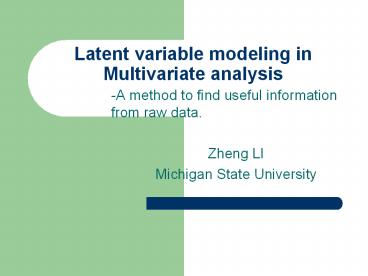Latent variable modeling in Multivariate analysis PowerPoint PPT Presentation
1 / 26
Title: Latent variable modeling in Multivariate analysis
1
Latent variable modeling in Multivariate analysis
- -A method to find useful information from raw
data. - Zheng LI
- Michigan State University
2
Overview
- 1.Multivariate analysis
- 2.Latent variable modeling
- 3.Advance in Latent variable modeling
- 4.Application of Latent variable modeling
3
What does multivariate mean?
- More than one variable are needed to describe a
system - For example
- Weather
- 1.Humidity
- 2.Temperature
- 3.Pressure
- And so on
4
What can (do we want) multivariate analysis
(to)do?
- 1.Find an easier way to represent data.
- 2.Find out the distribution of the data.
- 3.Develop a model to predict a property of
interest based on the other descriptors. - For example
- Possibility of rainingF(humidity,
temperature, pressure,) - 4.Find out the cause-effects relation from the
data.
5
Difficulties in the way!
- How to deal with high dimensional system?
- Sometimes the dimensions ( number of
variables) even exceeds the number of samples. - How to deal with a system whose variables are not
independent? - Latent variable modeling is the solution!!!!
6
Why latent Variables?
- Latent variables are independent to each other
and more appropriate to be used to represent
system instead of the original variables. - Reduce the number of the variables, simplify the
investigated system.
7
Assumption of Latent variable modeling
- The investigated system is influenced by just a
few underlying variables.
measurements
x1 x2 x3 x4 x5 x6 x7
Linear or nonlinear combination
Latent variable
Lx1 Lx2 Lx3
estimate
Sx1 Sx2 Sx3
system
measure
8
Assumption of Latent variable models (continue)
- Lx s are estimates of Sx s, and they can span
- the same space. And S is related to L by usually
an unknown rotation matrix R.
9
How to define latent variables
- PCA principal component analysis
- PLS- partial least squares
- FDA-Fisher discriminant analysis
- are three common methods used to derive latent
variables.
10
PCA
Eigenvalue decomposition of X
11
PLS
12
FDA
13
FDA
Eigenvalue decomposition of w-1B
14
How to decide the number of latent variables?
- In PCA and FDA
- Based on the percent of the variance being
explained by the latent variable model.
15
How to decide the number of latent variables?
(continue)
- In PLS
- F-test
16
Advance in Latent variable model research
- 1.Multiblock methods.
- 2.Nonlinear methods.
- 3.Application in causality relation discovery.
17
Multiblock methods
- Multiblock means separate variables into
different groups according to expert knowledge or
variable clustering. - Including MBPCA and MBPLS
18
Latent variable in Causal modeling
- Latent variable modeling are used to identify the
important factors in a system based on the
analysis of loadings ( the coefficients of the
latent variables).
19
Latent variable in Causal modeling(continue)
Latent variable
Bayesian network analysis
20
Application in metabolic flux analysis (MFA)
measurements
MFA MODEL
Flux value data
Multivariate analysis
21
Application in metabolic flux analysis (MFA)
- Objective
- To develop model to relate metabolic fluxes, then
identify fluxes that is important to the function
of a cell. - Urea productionF(other flux value of liver cell)
22
Application in metabolic flux analysis-FDA
23
Application in metabolic flux analysis- PLS
24
Application in metabolic flux analysis- PLS
(continue)
25
Application in metabolic flux analysis- causal
modeling
26
Conclusion
- Latent variable modeling can help us to simplify
a system. - Latent variable modeling can help us to uncover
the underlying mechanism of the system.

